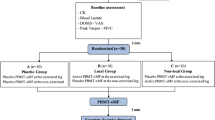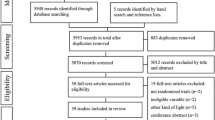Abstract
Photobiomodulation (PBM) therapy has been implicated as an effective ergogenic aid to delay the onset of muscle fatigue. The purpose of this study was to examine the dose–response ergogenic properties of PBM therapy and its ability to prolong time to task failure by enhancing muscle activity and delaying the onset of muscle fatigue using a static positioning task. Nine participants (24.3 ± 4.9 years) received three doses of near-infrared (NIR) light therapy randomly on three separate sessions (sham, 240, and 480 J). For the positioning task, participants held a 30 % one-repetition maximum (1-RM) load using the index finger until volitional fatigue. Surface electromyography (sEMG) of the first dorsal interosseous muscle was recorded for the length of the positioning task. Outcomes included time to task failure (TTF), muscle fatigue, movement accuracy, motor output variability, and muscle activity (sEMG). The 240-J dose significantly extended TTF by 26 % (p = 0.032) compared with the sham dose. TTF for the 240-J dose was strongly associated with a decrease in muscle fatigue (R 2 = 0.54, p = 0.024). Our findings show that a 240-J dose of NIR light therapy is efficacious in delaying the onset and extent of muscle fatigue during submaximal isometric positioning tasks. Our findings suggest that NIR light therapy may be used as an ergogenic aid during functional tasks or post-injury rehabilitation.



Similar content being viewed by others
Abbreviations
- ANOVA:
-
Analysis of variance
- ATP:
-
Adenosine triphosphate
- sEMG:
-
Surface electromyography
- FDA:
-
Food and Drug Administration
- FDI:
-
First dorsal interosseous
- J:
-
Joule
- LEDs:
-
Light-emitting diodes
- MCP:
-
Metacarpophalangeal
- MVC:
-
Maximal voluntary contraction
- NIR:
-
Near-infrared
- PBM:
-
Photobiomodulation
- RMSE:
-
Root-mean-square error
- SD:
-
Standard deviation
- SPI:
-
Second palmar interosseous
- TTF:
-
Time to task failure
References
Aimbire F, Albertini R, Pacheco MT, Castro-Faria-Neto HC, Leonardo PS, Iversen VV, Lopes-Martins RA, Bjordal JM (2006) Low-level laser therapy induces dose-dependent reduction of TNF alpha levels in acute inflammation. Photomed Laser Surg 24(1):33–37
Amaral AC, Parizotto NA, Salvini TF (2001) Dose-dependency of low-energy HeNe laser effect in regeneration of skeletal muscle in mice. Lasers Med Sci 16(1):44–51
Baptista J, Martins MD, Pavesi VC, Bussadori SK, Fernandes KP, Pinto Júnior Ddos S, Ferrari RA (2011) Influence of laser photobiomodulation on collagen IV during skeletal muscle tissue remodeling after injury in rats. Photomed Laser Surg 29(1):11–17. doi:10.1089/pho.2009.2737
Desmet KD, Paz DA, Corry JJ, Eells JT, Wong-Riley MT, Henry MM et al (2006) Clinical and experimental applications of NIR-LED photobiomodulation. Photomed Laser Surg 24(2):121–128
Reddy GK, Stehno-Bittel L, Enwemeka CS (1998) Laser photostimulation of collagen production in healing rabbit Achilles tendons. Lasers Surg Med 22(5):281–287
Samoilova KA, Zhevago NA, Menshutina MA, Grigorieva NB (2008) Role of nitric oxide in the visible light-induced rapid increase of human skin microcirculation at the local and systemic level: I. diabetic patients. Photomed Laser Surg 26:433–442. doi:10.1089/pho.2007.2197
Schindl A, Heinze G, Schindl M, Pernerstorfer-Schön H, Schindl L (2002) Systemic effects of low-intensity laser irradiation on skin microcirculation in patients with diabetic microangiopathy. Microvasc Res 64:240–246
Schindl A, Schindl M, Schon H, Knobler R, Havelec L, Schindl L (1998) Low-intensity laser irradiation improves skin circulation in patients with diabetic microangiopathy. Diabetes Care 21:580–584
Silveira PCL, Silva LA, Fraga DB, Freitas TP, Streck EL, Pinho R (2009) Evaluation of mitochondrial respiratory chain activity in muscle healing by low-level laser therapy. J Photochem Photobiol B Biol 95:89–92. doi:10.1016/j.jphotobiol.2009.01.004
Bjordal JM, Baxter GD (2006) Ineffective dose and lack of laser output testing in laser shoulder and neck studies. Photomed Laser Surg 24(4):533–534
Enoka RM, Duchateau J (2008) Muscle fatigue: what, why and how it influences muscle function. J Physiol 586(1):11–23
Hunter SK, Duchateau J, Enoka RM (2004) Muscle fatigue and the mechanisms of task failure. Exerc Sport Sci Rev 32(2):44–49
Chertok VM, Kotsyuba AE, Bespalova EV (2008) Role of nitric oxide in the reaction of arterial vessels to laser irradiation. Bull Exp Biol Med 145:751–754
Ihsan FRM (2005) Low-level laser therapy accelerates collateral circulation and enhances microcirculation. Photomed Laser Surg 23(3):289–294
Maegawa Y, Itoh T, Hosokawa T, Yaegashi K, Nishi M (2000) Effects of near-infrared low-level laser irradiation on microcirculation. Lasers Surg Med 27(5):427–437
Samoilova KA, Zhevago NA, Petrishchev NN, Zimin AA (2008) Role of nitric oxide in the visible light-induced rapid increase of human skin microcirculation at the local and systemic levels: II. healthy volunteers. Photomed Laser Surg 26(5):443–449. doi:10.1089/pho.2007.2205
Vladimirov YA, Osipov AN, Klebanov GI (2004) Photobiological principles of therapeutic applications of laser radiation. Biochemistry (Mosc) 69:81–90
Xu X, Zhao X, Liu TC-Y, Pan H (2008) Low-intensity laser irradiation improves the mitochondrial dysfunction of C2C12 induced by electrical stimulation. Photomed Laser Surg 26(3):197–202. doi:10.1089/pho.2007.2125
Larkin KA, Martin JS, Zeanah EH, True JM, Braith RW, Borsa PA (2012) Limb blood flow after class 4 laser therapy. J Athl Train 47:178–183
Allen DG, Lamb GD, Westerblad H (2008) Skeletal muscle fatigue: cellular mechanisms. Physiol Rev 88:287–332. doi:10.1152/physrev.00015.2007, Review
Larkin-Kaiser KA, Christou E, Tillman M, George S, Borsa PA (2015) Near-infrared light therapy to attenuate strength loss after strenuous resistance exercise. J Athl Train 50(1):45–50. doi:10.4085/1062-6050-49.5.05
Oldfield RC (1971) The assessment and analysis of handedness: the Edinburgh inventory. Neuropsychologia 9(1):97–113
Carpentier A, Duchateau J, Hainaut K (2001) Motor unit behaviour and contractile changes during fatigue in the human first dorsal interosseus. J Physiol 534(3):903–912
Kwon M, Baweja HS, Christou EA (2011) Age-associated differences in positional variability are greater with the lower limb. J Mot Behav 43(5):357–360. doi:10.1080/00222895.2011.598893
Baroni BM, Leal Junior ECP, Geremia JM, Diefenthaeler F, Vaz MA (2010) Effect of light-emitting diodes therapy (LEDT) on knee extensor muscle fatigue. Photomed Laser Surg 28(5):653–658. doi:10.1007/s00421-010-1562-z
Kwon M, Chen Y-T, Fox EJ, Christou EA (2014) Aging and limb alter the neuromuscular control of goal-directed movements. Exp Brain Res 232(6):1759–1771. doi:10.1007/s00221-01403868-2
Baweja HS, Patel BK, Neto OP, Christou EA (2011) The interaction of respiration and visual feedback on the control of force and neural activation of the agonist muscle. Hum Mov Sci 30(6):1022–1038. doi:10.1016/j.humov.2010.09.007
Neto OP, Christou EA (2010) Rectification of the EMG signal impairs the identification of oscillatory input to the muscle. J Neurophysiol 103:1093–1103. doi:10.1152/jn.00792.2009
Neto OP, Baweja HS, Christou EA (2010) Increased voluntary drive is associated with changes in common oscillations from 13 to 60 Hz of interference but not rectified electromyography. Muscle Nerve 42:348–354. doi:10.1002/mus.21687
Leal Junior ECP, Lopes-Martins RAB, Vanin AA, Baroni BM, Grosselli D, De Marchi T, Iversen VV, Bjordal JM (2009) Effect of 830 nm low-level laser therapy on exercise-induced skeletal muscle fatigue in humans. Lasers Med Sci 24(3):425–431. doi:10.1007/s10103-008-0592-9
Leal Junior ECP, Lopes-Martins RAB, Baroni BM, De Marchi T, Taufer D, Manfro DS, Rech M, Danna V, Grosselli D, Generosi RA, Marcos RL, Ramos L, Bjordal JM (2009) Effect of 830 nm low-level laser therapy applied before high-intensity exercises on skeletal muscle recovery in athletes. Lasers Med Sci 24(6):857–863. doi:10.1007/s10103-008-0633-4
Leal Junior ECP, Lopes-Martins RAB, Dalan F, Ferrari M, Sbabo FM, Generosi RA, Baroni BM, Penna SC, Iversen VV, Bjordal JM (2008) Effect of 655-nm low-level laser therapy on exercise-induced skeletal muscle fatigue in humans. Photomed Laser Surg 26(5):419–424. doi:10.1089/pho.2007.2160
Kelencz CA, Muñoz ISS, Amorim CF, Nicolau RA (2010) Effect of low-power gallium-aluminum-arsenium noncoherent light (640 nm) on muscle activity: a clinical study. Photomed Laser Surg 28(5):647–652. doi:10.1089/pho.2008.2467
Acknowledgments
The authors would like to acknowledge the help of Jonathan Leake and Tanya Onushko with the computer programming. This research was supported in part by a grant from the National Institutes of Health (R01 AG 031769) to Evangelos A. Christou.
Author information
Authors and Affiliations
Corresponding author
Ethics declarations
Conflict of interest
The authors declare that they have no conflict of interest.
Rights and permissions
About this article
Cite this article
Larkin-Kaiser, K.A., Borsa, P.A., Baweja, H.S. et al. Photobiomodulation delays the onset of skeletal muscle fatigue in a dose-dependent manner. Lasers Med Sci 31, 1325–1332 (2016). https://doi.org/10.1007/s10103-016-1979-7
Received:
Accepted:
Published:
Issue Date:
DOI: https://doi.org/10.1007/s10103-016-1979-7




